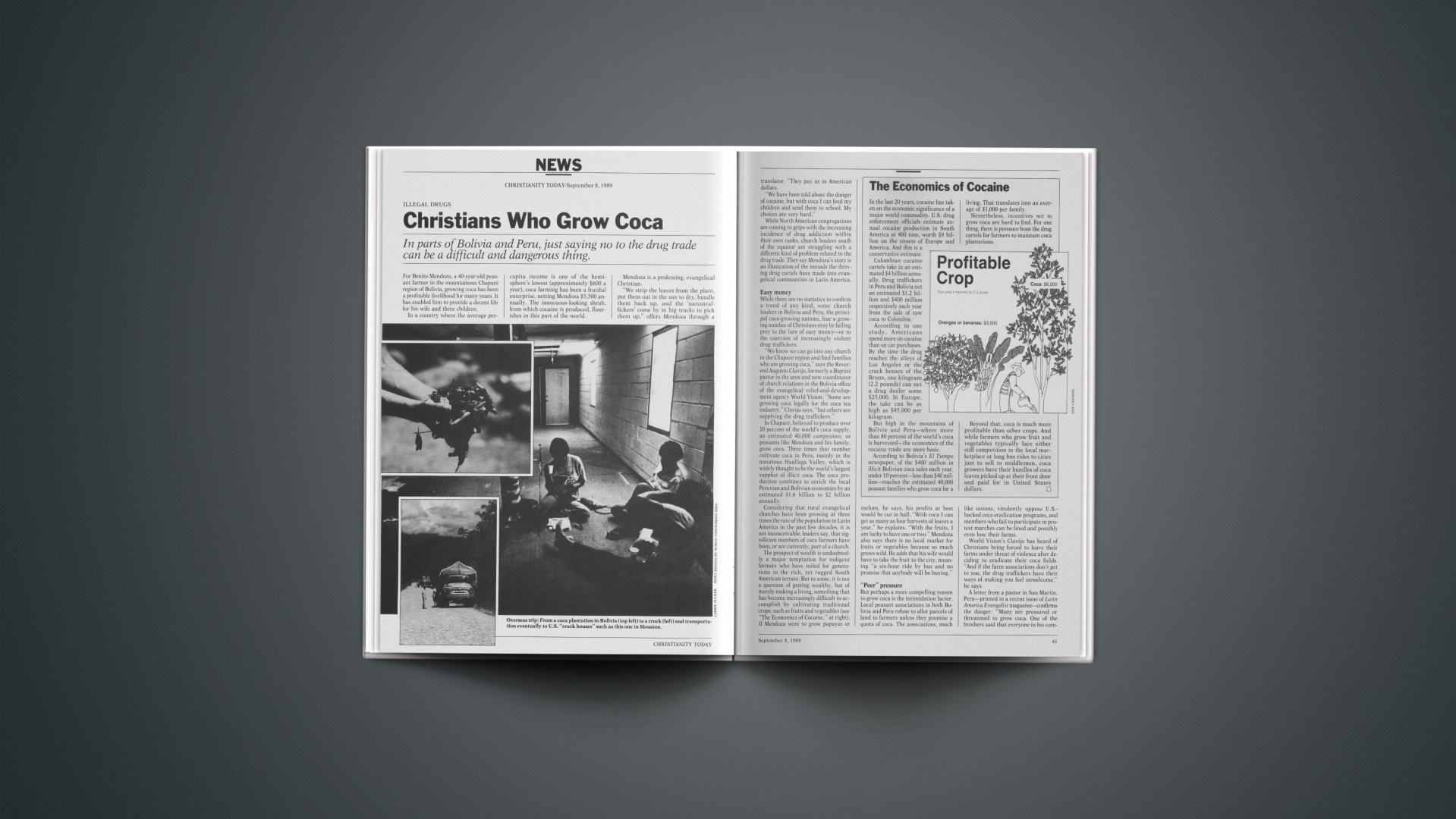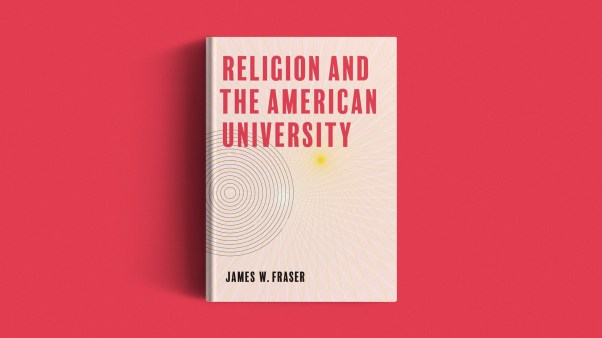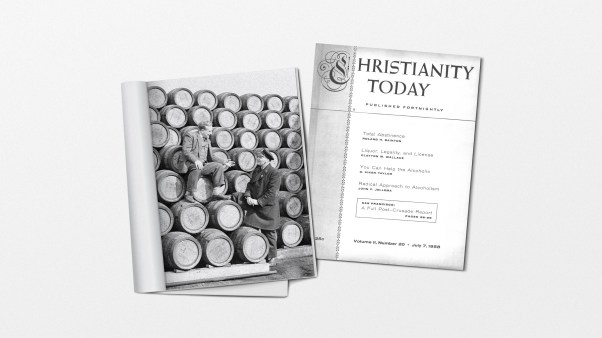CHRISTIANITY TODAY/September 8, 1989
In parts of Bolivia and Peru, just saying no to the drug trade can be a difficult and dangerous thing.
For Benito Mendoza, a 40-year-old peasant farmer in the mountainous Chaparé region of Bolivia, growing coca has been a profitable livelihood for many years. It has enabled him to provide a decent life for his wife and three children.
In a country where the average percapita income is one of the hemisphere’s lowest (approximately $600 a year), coca farming has been a fruitful enterprise, netting Mendoza $5,500 annually. The innocuous-looking shrub, from which cocaine is produced, flourishes in this part of the world.
Mendoza is a professing, evangelical Christian.
“We strip the leaves from the plant, put them out in the sun to dry, bundle them back up, and the ‘narcotraffickers’ come by in big trucks to pick them up,” offers Mendoza through a translator. “They pay us in American dollars.
“We have been told about the danger of cocaine, but with coca I can feed my children and send them to school. My choices are very hard.”
While North American congregations are coming to grips with the increasing incidence of drug addiction within their own ranks, church leaders south of the equator are struggling with a different kind of problem related to the drug trade. They say Mendoza’s story is an illustration of the inroads the thriving drug cartels have made into evangelical communities in Latin America.
Easy Money
While there are no statistics to confirm a trend of any kind, some church leaders in Bolivia and Peru, the principal coca-growing nations, fear a growing number of Christians may be falling prey to the lure of easy money—or to the coercion of increasingly violent drug traffickers.
“We know we can go into any church in the Chaparé region and find families who are growing coca,” says the Reverend Augusto Clavijo, formerly a Baptist pastor in the area and now coordinator of church relations in the Bolivia office of the evangelical relief-and-development agency World Vision. “Some are growing coca legally for the coca tea industry,” Clavijo says, “but others are supplying the drug traffickers.”
In Chaparé, believed to produce over 20 percent of the world’s coca supply, an estimated 40,000 campesinos, or peasants like Mendoza and his family, grow coca. Three times that number cultivate coca in Peru, mainly in the notorious Huallaga Valley, which is widely thought to be the world’s largest supplier of illicit coca. The coca production combines to enrich the local Peruvian and Bolivian economies by an estimated $1.6 billion to $2 billion annually.
Considering that rural evangelical churches have been growing at three times the rate of the population in Latin America in the past few decades, it is not inconceivable, leaders say, that significant numbers of coca farmers have been, or are currently, part of a church.
The prospect of wealth is undoubtedly a major temptation for indigent farmers who have toiled for generations in the rich, yet rugged South American terrain. But to some, it is not a question of getting wealthy, but of merely making a living, something that has become increasingly difficult to accomplish by cultivating traditional crops, such as fruits and vegetables (see “The Economics of Cocaine,” at right). If Mendoza were to grow papayas or melons, he says, his profits at best would be cut in half. “With coca I can get as many as four harvests of leaves a year,” he explains. “With the fruits, I am lucky to have one or two.” Mendoza also says there is no local market for fruits or vegetables because so much grows wild. He adds that his wife would have to take the fruit to the city, meaning “a six-hour ride by bus and no promise that anybody will be buying.”
The Economics of Cocaine
In the last 20 years, cocaine has taken on the economic significance of a major world commodity. U.S. drug enforcement officials estimate annual cocaine production in South America at 400 tons, worth $9 billion on the streets of Europe and America. And this is a conservative estimate.
Colombian cocaine cartels take in an estimated $4 billion annually. Drug traffickers in Peru and Bolivia net an estimated $1.2 billion and $400 million respectively each year from the sale of raw coca to Colombia.
According to one study, Americans spend more on cocaine than on car purchases. By the time the drug reaches the alleys of Los Angeles or the crack houses of the Bronx, one kilogram (2.2 pounds) can net a drug dealer some $25,000. In Europe, the take can be as high as $45,000 per kilogram.
But high in the mountains of Bolivia and Peru—where more than 80 percent of the world’s coca is harvested—the economics of the cocaine trade are more basic.
According to Bolivia’s El Tiempo newspaper, of the $400 million in illicit Bolivian coca sales each year, under 10 percent—less than $40 million—reaches the estimated 40,000 peasant families who grow coca for a living. That translates into an average of $1,000 per family.
Nevertheless, incentives not to grow coca are hard to find. For one thing, there is pressure from the drug cartels for farmers to maintain coca plantations.
Beyond that, coca is much more profitable than other crops. And while farmers who grow fruit and vegetables typically face either stiff competition in the local marketplace or long bus rides to cities just to sell to middlemen, coca growers have their bundles of coca leaves picked up at their front door and paid for in United States dollars.
“Peer” Pressure
But perhaps a more compelling reason to grow coca is the intimidation factor. Local peasant associations in both Bolivia and Peru refuse to allot parcels of land to farmers unless they promise a quota of coca. The associations, much like unions, virulently oppose U.S.-backed coca eradication programs, and members who fail to participate in protest marches can be fined and possibly even lose their farms.
World Vision’s Clavijo has heard of Christians being forced to leave their farms under threat of violence after deciding to eradicate their coca fields. “And if the farm associations don’t get to you, the drug traffickers have their ways of making you feel unwelcome,” he says.
A letter from a pastor in San Martin, Peru—printed in a recent issue of Latin America Evangelist magazine—confirms the danger: “Many are pressured or threatened to grow coca. One of the brothers said that everyone in his community had agreed to grow coca, and that anyone who didn’t would have to move out.”
Although none of the major denominations has officially condemned coca production, Clavijo said local pastors often preach courageously against the coca leaf. And the Pentecostal church has taken discipline one step further by not allowing coca growers to hold leadership positions in local congregations.
Victims of the Drug Trade
Runaway teenagers in an abandoned park smoking cigarettes made of cocaine paste and tobacco. Working couples hosting chic cocaine parties in their middle-class apartments. Homeless children inhaling glue and smoking marijuana all night long on deserted, dangerous city streets.
Detroit? Los Angeles? Not this time. These images of suffering and victimization caused by drug abuse come from Peru, Bolivia, Colombia, and dozens of other nations.
A growing number of international health experts fear that drug addiction—once considered the private reserve of nations with flourishing economies—now endangers the lives of hundreds of thousands, perhaps millions, in the poorer nations of the world.
Consider some recent statistics:
• According to Fortune magazine, Colombia—the world’s primary producer of cocaine—now has 500,000 regular smokers of cocaine, and “probably more cocaine addicts per capita than the United States.”
In Bogotá, Colombia’s posh capital, an estimated 5,000 preteen homeless children roam the streets at night, staying high on marijuana or the fumes of glue.
Or they smoke pasta basica, a gooey paste made of the residue of kerosene, sulfuric acid, and coca leaves left over after the processing of cocaine. Basuco—or “bazooka” as it’s called in Western vernacular—is mixed with tobacco and smoked in cigarette form.
• In Brazil, which has served as a passageway for Bolivian cocaine headed for Europe and the U.S., there are an estimated 2.5 million new cocaine addicts, 350,000 in the city of São Paulo alone.
• In Bolivia, recent reports put the number of teenage cocaine users at 5 percent of the adolescent population, or 80,000 youths.
In Cochabamba, a city of 250,000 near one of Bolivia’s prime coca-producing regions, an estimated three new addicts fall prey to cocaine each week. One Cochabamba police official said the biggest increase is among middle-class adults with new disposable dollars. “Cocaine is becoming the chic weekend drug of choice,” he said. “We’re now seeing the same kind of tragedy here we’ve heard about in the United States.”
One United Nations report predicts that drug abuse in developing nations could become the number-one health threat to the have-not nations in the 1990s, beyond malnutrition, preventable diseases, and perhaps even AIDS.
Anticoca Preaching
But sometimes anticoca sermons can be costly, according to Humberto Flores, a long-time minister with the Bolivian Baptist Union. “It appears that the cocaine traffickers have infiltrated all the community groups—even churches—where they think they can influence public opinion in their favor,” said Flores. “For instance, a pastor who preaches against coca sees his church’s offerings suddenly dry up. It’s a warning that he’s treading on dangerous ground. If he persists, the congregation is likely to vote to dismiss him as their minister.”
Miriam Goytia, former president of the youth alliance of the Bolivian Baptist Union, remembers the day two years ago when drug traffickers in the Chaparé region stormed an anticoca youth rally. “We were in the middle of singing when all these men with masks and guns broke in and told us we had to disband,” recalls Goytia. “Since then, we haven’t been able to find local support for any further events.”
In 1986 the U.S., in cooperation with Bolivian antidrug officials, applied force to the coca problem. Dubbed “Operation Blast Furnace,” American troops, armed with flame throwers and special radar equipment, swarmed through the Bolivian countryside, identifying and destroying many large coca plantations, and dismantling several major cocaine laboratories.
Additionally, an agreement was worked out to make cash payments to small farmers if they voluntarily agreed to eradicate their coca crops. Many did, but most are still waiting for their payments, according to local drug-enforcement authorities.
Clavijo said organizations such as World Vision, in conjunction with local churches, are looking for other ways to provide incentives to Christian farmers not to grow coca. These might include helping farmers establish agricultural cooperatives in order to increase their buying and selling power in the produce marketplace.
Taking A Stand
But these programs have yet to be established, Clavijo says, because it is difficult to find participants willing to take the risk. Meanwhile, it is a rare Christian farmer who voluntarily stops growing coca.
One such farmer is Bernardo Arandia, a 43-year-old campesino with five children and a small farm in Chaparé. One Sunday earlier this year, Arandia’s pastor preached a sermon at the local Baptist church about the evils of coca.
“The pastor told us about all the people in America who have died because of coca. He told us we must know the truth about cocaine. It is a destroyer, like Satan. He told us that as Christian farmers, we must produce crops that give life, not take it away,” remembers Arandia, through a translator. “I decided that day to bum my coca, and I would never grow coca again.”
For Arandia, following his convictions has been difficult. “I hear about all these families with sacks of dollars piling up in their houses, and I see that my children are more hungry now than they’ve ever been. Sometimes, coca tempts me to grow again, because I see people who grow it turning rich overnight.
“But I know, as a Christian, that I cannot do it anymore. And I know God will somehow bless me for doing the right thing.”
By Brian Bird in South America.
Brief History
The harmless-looking coca plant has mystified and seduced humankind for centuries. The earliest indication of coca’s use as a narcotic dates to the South American Valdivia people in 1500 B.C. A three-inch ceramic bust of a Valdivian man, his cheeks bulging with leaves, is on display in a museum in Ecuador.
When the Spaniards arrived in South America in the fifteenth century, they found Indians chewing leaves from the strange plant. A Spanish soldier, Pedro de Cieza de Leon, recorded in his diary: “When I asked some of the Indians why they always had their mouths full of this plant, they said that with it they do not feel hunger and it gives them great vigor and strength.”
In 1862, German scientists identified a chemical compound in coca leaves and called it cocaine. In the decades that followed, physicians and psychiatrists—including Sigmund Freud—experimented with cocaine as a treatment for opium addiction and alcoholism, and as a stimulant for depression.
In America, early in this century, doctors patented cocaine-laced remedies for asthma, hay fever, and sinusitis. Industrialists also began marketing an assortment of beverages containing small amounts of cocaine, including Coca-Cola.
But the euphoria over cocaine was soon replaced by anguished stories of incurable addiction, and in 1914 the drug was outlawed in the U.S. In 1961, 125 nations ratified an international treaty outlawing the production or possession of cocaine, except for medical use.
Today, the indigenous habit of chewing coca leaves is still widely practiced among native South Americans. In Bolivia, coca growers legally produce small amounts of coca leaves to be used for coca tea, a harmless drink that alleviates upset stomach and altitude sickness.
Meanwhile, developed nations are trying to stop the flow into their countries of a drug that claims millions of addicts.










